Carter Seminary Ardmore Oklahoma, Chickasaw Boulevard and Highway 142.
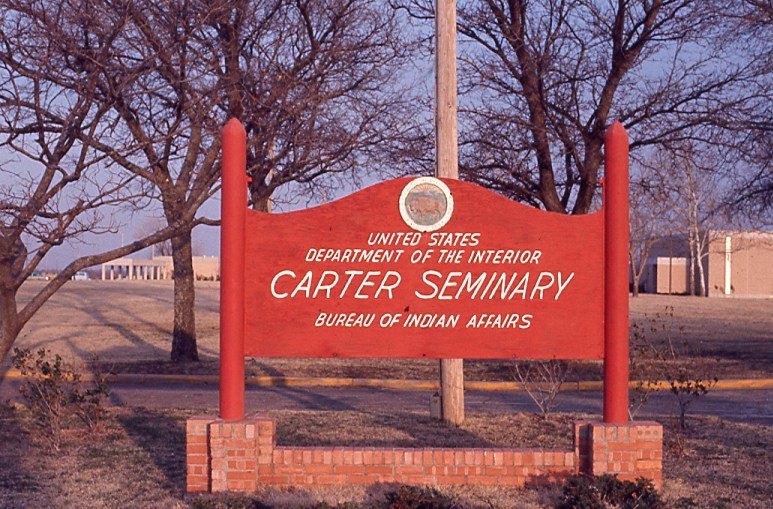
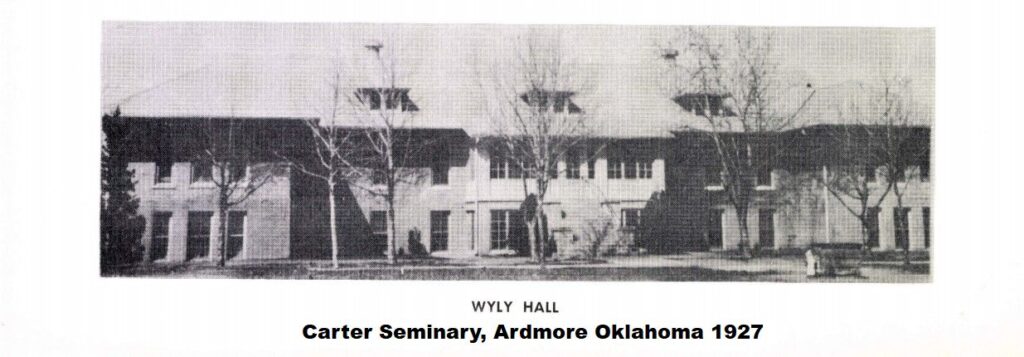
Carter Seminary
The story of the Carter Seminary at Ardmore goes back to 1852 when it was founded south of Durant as Bloomfield Academy for Indian girls. The school was jointly sponsored by the Methodist Indian Conference and the Chickasaw Nation. Reverend John Harpole Carr, the founder, selected the wilderness site and helped with the construction. He had been reared under primitive frontier conditions in a sparsely settled section of Arkansas Territory and was well prepared for the struggles of building a new school in a rugged country.
Reverend Carr was skilled with tools and did much to the school’s maintenance work himself in order to stretch the meager budget. He supplied most of the coffins for the community. He cultivated a farm and orchard to help with his school’s larder.
The Civil War brought education to a halt at Bloomfield and found the building being used as a hospital and commissary within the Confederate States and cut off from all federal aid.
At the opening of the war the educational work which had been in the hands have the missionary societies of the various churches came to an abrupt stop and was not resumed at the close of the war. The schools which had been erected and held jointly by the church and the Chickasaw Nation now became the property of the Nation, which took up the work of rehabilitating its educational system.
After the war, Confederate Capt. Frederick Young picked up what pieces were left and begin a neighborhood school at the site of Bloomfield. The old traditions had too strong a hold on the people to permit a Broomfield permanent abandonment. Among the boys who attended at this time was Douglas H. Johnston, who many years later was to serve as Bloomfield superintendent for 13 years and as governor of the Chickasaw Nation until Oklahoma became a state and served as the appointed Governor until his death in 1943.
An accidental fire had destroyed most of the old buildings, but they were replaced by better ones, some of brick construction. Rev. Carr had returned, but left in 1867 and was replaced by Dr. and Mrs H. F. Murray. The stayed two years and were followed by Robert Cole who stayed five years. During Cole’s administration the school received an annuity of $5,700. High School grades were added and enrollment was raised to 45.
J. W. Horton became superintendent for the next 4 years, 1876 to 1880. The Chickasaw legislature enacted laws putting the academy back to their old, original status as boarding schools with wide latitude for their own government and management.
Wharton was followed by Robert L Boyd. Student Douglas H Johnston returned as superintendent in 1882 and served until 1895 when E. B. Henshaw became superintendent. The school was at its best during the Johnston-Henshaw era. The high standards, manners and poise of the students gave rise to their being called “Bloomfield Blossoms” and graduates wore a tiny gold blossom emblem on their graduation caps.
In 1906 the U. S. government assumed responsibility for all Indian schools. J. R. Hendrix who had also been in charge of the Ardmore schools, became superintendent. He was followed in 1910 by Annie Ream Addington who held the position until fire again destroyed the school plant. Bloomfield was never rebuilt on the old site.
The government purchased the old Hargrove College plant at Ardmore and Bloomfield had a new home. There have been many editions made.
Miss M. E. Allen became superintendent in 1916. The school was opened in October 1917 to Indian girls. Miss Allen resigned in 1921 and was replaced by Miss Minta R. Foreman. Miss Foreman was in turn replaced in 1923 by Miss Allen, who remained until her retirement in 1934. Subsequent superintendents have been Miss Eva Lowers, Joseph B. Vernor, William T. Johnson and L. E. Larson, the present superintendent.
This school has its own dairy, laundry and other facilities that make itself sufficient to a large degree and also provide vocational and homemaking training for the students.
In 1934 Bloomfield Academy was renamed Carter Seminary in honor of Charles B. Carter. Carter was instrumental in securing many needed improvements for the school. He was a Chickasaw and Cherokee descent.
In 1949 boys were again taken at students after a lapse of many years strictly a girls’ school.
Carter Seminary is now operated by the U.S. Department of the Interior, Office of Indian Affairs and pupils are enrolled from all the Five Civilized Tribes, as the five main tribes that lived south of Virginia after the American Revolution came to be known. -Carter County History book 1957
The Ardmore facility ceased to be Carter Seminary in 2004.
Ken Milburn Ford, also was McCulloh Olds and Cadillac, which would later become the Carter County Health Department at West Broadway and C Street NW.
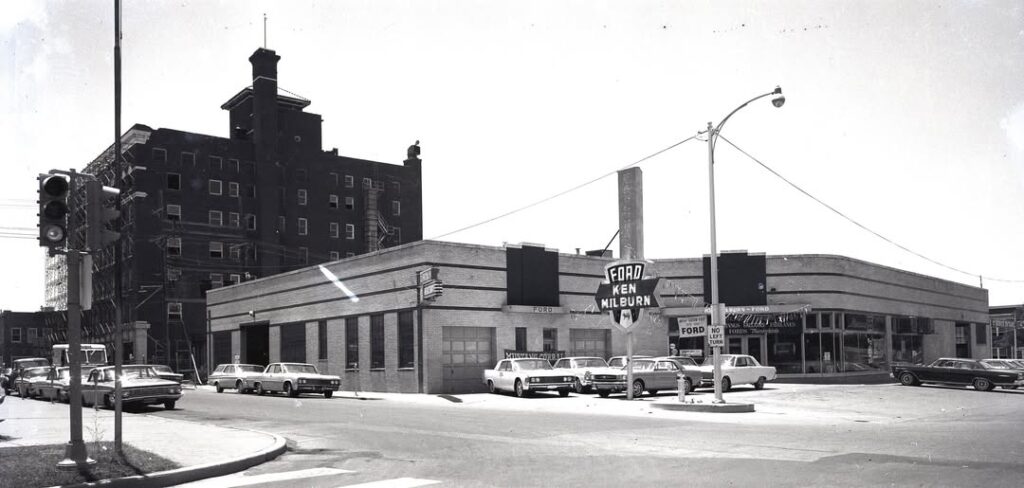
Antlers, Oklahoma about 1900
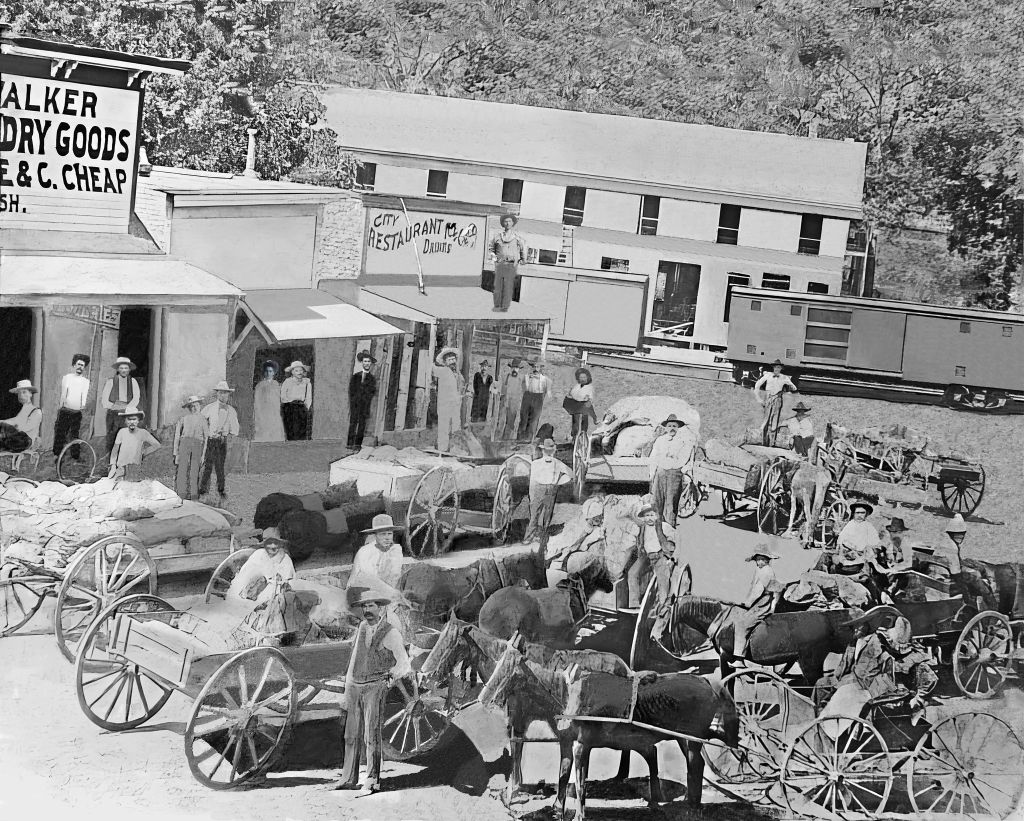
Mail from the Mailbag
Butch > Speakin’ of the Tivoli > remember when we were wee lads & you could watch movies every Saturday for the low low entry fee of just one empty coke bottle ? After the Saturday movie fest, it was a short jog over to Miller’s Dairy Queen for a soft-serve cone. Speakin’ of burgers, what was the name of that burger joint over on Washington St that used to keep track of how many burgers they had sold to date ? Just like McDonalds. They had a sack sale, and by the time you got home with the sack, it was soaked thru & thru with grease. Yum ! ood times ! Remember when we used to ride our bikes over to the Coke plant on Washington St and watch the bottles being filled through the windows as they passed by on the conveyor. Then it was over to the RR tracks to have pennies smashed by the passing trains. Would not happen today ! No kids on bikes, just street people on bikes WITH cell phones. Kids are exercising their thumbs instead of their legs these days. Ever try to get their attention during this particularexercise ? The times ARE a-changin’……..
-Steve Miller (like the band)
HAM Talk by Butch Bridges KC5JVT – Allstar node # 58735
The Arbuckle 97 Net conducts a check-in every Sunday night at 8:00pm. Any licensed HAM is welcome to check-in.
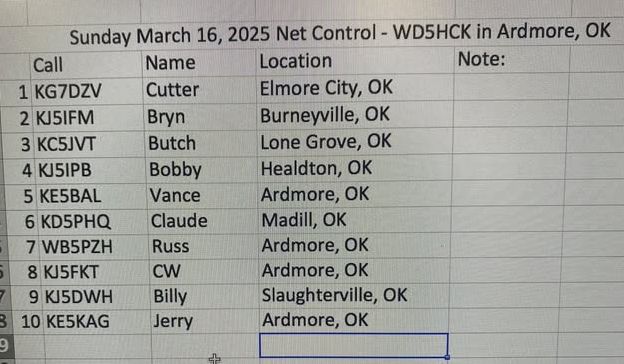

Below is from my newsletter archives dated
March 13, 2008 – Issue 581
The county bought two really nice water trucks this week using the new volunteer fire department tax fund money. The trucks are used but in great condition as you can see in the pictures below submitted by Doug Williams. These particular water trucks were purchased for the Healdton and Woodford Fire Departments.
https://oklahomahistory.net/ttphotos8a/WoodfordHealdtonFD8a.jpg
https://oklahomahistory.net/ttphotos8a/WoodfordHealdtonFD8b.jpg
https://oklahomahistory.net/ttphotos8a/WoodfordHealdtonFD8c.jpg
https://oklahomahistory.net/ttphotos8a/WoodfordHealdtonFD8d.jpg
https://oklahomahistory.net/ttphotos8a/WoodfordHealdtonFD8e.jpg
https://oklahomahistory.net/ttphotos8a/WoodfordHealdtonFD8f.jpg
Butch, over east of Lebanon, Oklahoma is this old building named the Burney Institute. I guess it was an Indian school at one time.
https://oklahomahistory.net/ttphotos8a/BurneyInstitute8a.jpg
https://oklahomahistory.net/ttphotos8a/BurneyInstitute8b.jpg
Q. “I was watching a movie “Bury My Heart At Wounded Knee” and a Indian actor named Wes Studi was from Nofire Hollow, Oklahoma. I looked on Google Earth and nothing comes up. Anyone know exactly where Nofire Hollow, Oklahoma is located?”
A. Near Welling, Oklahoma 35.874543806182864, -94.57163662734119
https://en.wikipedia.org/wiki/Welling,_Oklahoma
“I didn’t think to tell you last week but at one time there was a historical marker where the hotel used to be at Oil Springs. The last time I hunted there an oil company had done a bunch of dozing there and I couldn’t find it. The Love cemetery is easy to get to. It is on the other side of the creek and you can drive right to it. We had to go to the hotel site from the south end of the hunting area and the last time I was there the private land we had to cross had a locked gate.”
Directions: When you come out of Marietta going east on 32 that first big curve that turns back north you go around it and there is a road that goes west. It was 5 mile section line road at the time. You run into private land with a locked gate the last time I tried to go in. It goes in to the south end of the Hickory Creek public hunting area. You couldn’t drive on the hunting area you had to walk. If you go to Your right down the fence you come to a corner where the fence turns back North. The Historical marker was in that corner until the oil Co. did a bunch of dozer work and I couldn’t find it again. The cemetery is farther north and you can drive to it from the West side of the hunting area.
There was also a natural oil spring at the old Peter Maytubby place, about six miles northwest of the present town of Caddo, Bryan County, Oklahoma. Years ago a hotel was opened at Maytubby Springs, and the place became well known as a resort in this country and the surrounding states.
“Butch, The older I get the more I think about Ardmore. I just read “Territorial Town-The Ardmore Story” and “The Real All Americans”. It makes one feel old when one reads a history book and can remember many of the people and places in it. I appreciate your efforts in trying to keep the history of Ardmore alive. Even though we were in the same HS class, I don??Tt remember spending much time with you, which is my loss. As for my family, JB BOONE, Sr., great grandfather, came to Ardmore from Waxahachie, Texas in 1903 and somehow ended up with land on S. Commerce. My grandfather, Dan L. Mahoney came from Boston and my dad, Dan B., graduated from AHS. I ended up with the land, and even though my children did not grow up in Ardmore they did grow up on the farm. Would like to hear from long time friends. Congratulations on your addition, Jill. If you have a newsletter, please attach me to your list. E-mail is best.” -Danny Mahoney
“When you get to the web page on the following link, click on “Initial point of Oklahoma” on the left side of the page.” -Duane Stevens
The Wilson News by Mindy Taylor
1-27-1916
Dancing is getting to be quite popular here. Most every night after the show the chairs are removed and a big dance is pulled off by the young folks of the city. Come out and watch them “tango”.
2-10-1916
Quite a lot of booze was captured last night by Charley Jones and Frank James, almost every one that was on the streets had to go through the ordeal of being searched, several walking saloons were raided and the goods confiscated.
2-24-1916
Wilson Has a Booster Club
The later part of last week the merchants of Wilson organized what is to be known as the business mens booster club, with P. W. McKay, Pres. W. B. Barnett, Sec. This organization will be a big benefit to Wilson and is something we have long been in need of.
2-24-1916
The merchants of New Wilson, in keeping abreast of the times, has set aside the 2nd Monday of every month as a trades day for the farmers of this community.
https://www.wilsonmuseum.org/
When I think back the past few years when some of the most famous entertainers in this country have sung our National Anthem (Est by Congress in 1931) in a disrespectful way at the Super Bowls, etc., it really does my soul good to see the young Americans in the youtube link below sing it the way it was intended to be sung. Below is a link to a video of the Cactus Cuties, five very talented young ladies. They are Andi Kitten 11, Baylee Barrett 13, Madeline Powell 8, Tatum Lowe 11, and Blaire Elbert 10, singing The Star Spangled Banner. The performance was at the Texas Tech vs Texas basketball game January 20, 2008 in front of over 11,000 people. The group is named for the Cactus Theater in Lubbock, Texas (home of the Buddy Holley Festivals) and are coached by Cami Caldwell.
The old saying “March comes in like a lion” is a weather folklore that suggests March’s weather can be harsh and unpredictable at the beginning of the month, like a roaring lion, but then mellows out, like a lamb, as the month progresses
Butch and Jill Bridges
Ardmore Oklahoma
580-490-6823
https://oklahomahistory.net
